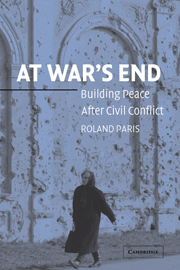Book contents
- Frontmatter
- Contents
- List of Figures
- Preface
- Introduction
- PART I FOUNDATIONS
- PART II THE PEACEBUILDING RECORD
- PART III PROBLEMS AND SOLUTIONS
- 9 The Limits of Wilsonianism: Understanding the Dangers
- 10 Toward More Effective Peacebuilding: Institutionalization Before Liberalization
- 11 Lessons Learned and Not Learned: Kosovo, East Timor, Sierra Leone, and Beyond
- Conclusion
- Bibliography
- Index
9 - The Limits of Wilsonianism: Understanding the Dangers
Published online by Cambridge University Press: 05 September 2012
- Frontmatter
- Contents
- List of Figures
- Preface
- Introduction
- PART I FOUNDATIONS
- PART II THE PEACEBUILDING RECORD
- PART III PROBLEMS AND SOLUTIONS
- 9 The Limits of Wilsonianism: Understanding the Dangers
- 10 Toward More Effective Peacebuilding: Institutionalization Before Liberalization
- 11 Lessons Learned and Not Learned: Kosovo, East Timor, Sierra Leone, and Beyond
- Conclusion
- Bibliography
- Index
Summary
Despite the many differences among the eleven peacebuilding operations launched between 1989 and 1998, these missions have pursued a broadly common strategy, seeking to transform war-shattered states into liberal market democracies on the assumption that doing so would help to consolidate a stable and lasting peace. As noted in Part I, this strategy rested on a proposition that liberal thinkers have propounded in one form or another since the eighteenth century, and which gained widespread acceptance among scholars and policymakers at the end of the Cold War: that liberal democracy and market-oriented economics offer the surest formula for peace, both in relations between states and within their borders. I labeled this the Wilsonian approach to conflict management and noted that this method of conflict management is still largely unproven, because questions such as whether the process of liberalization fosters peace, and whether democratization and marketization are reliable remedies for intrastate violence, remain largely unanswered. The case studies examined in the preceding chapters were conducted in the hope of gaining new insights into these questions.
Some missions were clear successes (Namibia and Croatia); others were obvious failures (Angola and Rwanda). The remaining operations fell in between these two extremes. In most of these eleven cases, the process of political liberalization, or economic liberalization, or both, produced destabilizing side effects that worked against the consolidation of peace. In some countries, liberalization exacerbated societal tensions, and in others it reproduced traditional sources of violence.
- Type
- Chapter
- Information
- At War's EndBuilding Peace after Civil Conflict, pp. 151 - 178Publisher: Cambridge University PressPrint publication year: 2004



